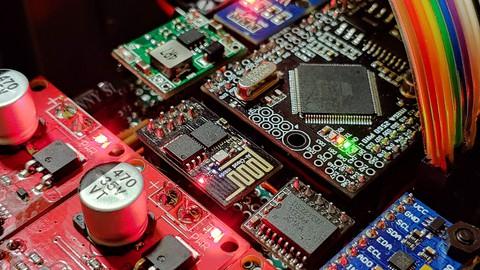Last Updated on October 26, 2023 by GeeksGod
Course : Mastering 8051 Assembly Language Programming
Free Udemy Coupon, 8051 Assembly Language: A Comprehensive Guide
In this comprehensive course on 8051 Assembly Language programming, we will explore the intricacies of programming 8051 Family Microcontrollers. Whether you’re a beginner or have some experience in embedded systems, this course is designed to take you from the fundamentals to advanced concepts.
Why Learn 8051 Assembly Language?
Assembly language is a low-level programming language that provides direct control over the microcontroller’s hardware. Understanding assembly language programming is crucial for professionals working with embedded systems, as it allows for efficient and optimized code development.
Benefits of Learning 8051 Assembly Language with Us
By enrolling in our course, you’ll gain access to:
- Hands-on exercises and simulations to practice your assembly language programming skills
- Detailed explanations of the 8051 Microcontroller architecture and its various variants
- Guidance on selecting the right Microcontroller for specific application requirements
- Insights into hexadecimal numbers and their significance in assembly language programming
- Knowledge of program memory, data memory, and bit addressability
- Expertise in using the Keil Integrated Development Environment (IDE)
- The ability to perform single byte and double byte addition operations
- Understanding of the Program Status Word (PSW) Flags and overflow in addition operations
- Familiarity with stack operations and its importance in program execution
- Practical implementation of assembly language programs, such as calculating the sum of natural numbers and achieving multiplication through repeated addition
- Mastery in working with Input/Output (I/O) Ports and logical instructions for data manipulation
- Knowledge of single bit instructions for precise control
Who Should Take This Course?
This course is tailored for:
- Beginners aspiring to enter the embedded systems field
- Professionals seeking to enhance their understanding of assembly language programming
- Engineering students studying computer architecture or microprocessors
Prerequisites
No prior programming experience is necessary to enroll in this course. We start from the basics and gradually progress to advanced topics. Familiarity with basic computer concepts and binary numbers is helpful but not mandatory.
Free Udemy Coupon, 8051 Assembly Language: Course Overview
Introduction to Assembly Language Programming
Before diving into assembly language programming, it’s essential to understand the differences between microprocessors and microcontrollers. We’ll explore the various variants of microcontrollers available in the market and discuss the criteria for selecting the appropriate microcontroller for specific applications.
Internal Architecture of the 8051 Microcontroller
In this section, we’ll take a deep dive into the internal architecture of the 8051 Microcontroller. You’ll gain a comprehensive understanding of its various components and their functionalities, including program memory, data memory, registers, and more.
Working with Hexadecimal Numbers
Hexadecimal numbers play a crucial role in assembly language programming. We’ll teach you how to work with hexadecimal numbers and convert them to binary and decimal formats.
Bit Addressability and its Application to Registers
Bit addressability allows for efficient manipulation of individual bits within registers. We’ll explore the concept of bit addressability and its application to registers in the 8051 Microcontroller.
Program Counter and Stack Pointer
A program counter keeps track of the currently executing instruction, while a stack pointer helps manage the function call stack. We’ll differentiate between a program counter and a stack pointer and explain their roles in program execution.
Getting Started with Keil IDE
The Keil Integrated Development Environment (IDE) is a powerful tool for writing, compiling, and debugging assembly language programs. We’ll guide you through the installation process and teach you how to effectively use the Keil IDE.
Single Byte Addition
Single byte addition is a fundamental operation in assembly language programming. We’ll walk you through the process of performing single byte addition operations using the 8051 Microcontroller.
Double Byte Addition
Extending our knowledge from single byte addition, we’ll cover double byte addition operations. You’ll learn how to handle larger numbers and perform addition operations on multiple bytes.
Understanding the Program Status Word (PSW) Flags
The Program Status Word (PSW) flags provide essential information about the status of the 8051 Microcontroller. We’ll explain the significance of each flag and how they affect program execution.
Overflow in Addition Operations
Overflow occurs when the result of an addition operation exceeds the maximum representable value. We’ll delve into the concept of overflow and teach you how to handle it effectively in assembly language programming.
The Importance of the Stack in Program Execution
The stack is a crucial component in program execution, allowing for the efficient management of function calls and return addresses. We’ll explore the importance of the stack and how to utilize it effectively in your assembly language programs.
Assembly Language Program Implementations
We’ll provide practical examples of assembly language programs to solidify your understanding. You’ll implement programs to calculate the sum of the first five natural numbers and achieve multiplication through repeated addition.
Programming Input/Output (I/O) Ports
Input/Output (I/O) ports allow for communication between the microcontroller and external devices. We’ll teach you how to program I/O ports to input and output data.
Logical Instructions for Data Manipulation
Logical instructions enable data manipulation within the microcontroller. We’ll cover logical instructions and teach you how to perform logical operations on data.
Single Bit Instructions for Precise Control
In situations that demand precise control over specific bits, single bit instructions come in handy. We’ll explore single bit instructions and their applications in assembly language programming.
Free Udemy Coupon, 8051 Assembly Language: Where to Go From Here
After completing this course, you’ll have a solid foundation in 8051 Assembly Language programming. You can further enhance your skills by exploring more complex topics, such as interrupts, timers, and serial communication. Additionally, you can delve into other microcontroller architectures and expand your knowledge in embedded systems development.
Enroll now and take the first step towards becoming an expert in 8051 Assembly Language programming!














